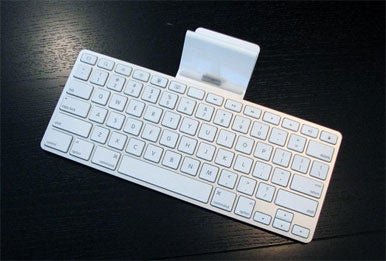Apple CEO Steve Jobs added: “It feels great to have the iPad launched into the world—it’s going to be a game changer.”
By comparison, Apple sold 270,000 original iPhones in the first 30 hours or so of its availability. That’s right, the iPad outsold the iPhone on day one—and that’s for a “third” device in an unproven category. You could argue that the ability to pre-order increased the window for people to buy, but I think that washes out with the fact that almost everybody who pre-ordered had never so much as touched the device.
Comparisons to later iPhone models aren’t too shabby either. Apple sold one million of both the iPhone 3G and the iPhone 3GS in each of their first weekends—that’s an average of about 333,333 per day. It took the original iPhone 74 days to reach its millionth sale, so all eyes will be on Apple to see when the iPad hits that milestone.
And make no mistake: both apps and e-books are going to be a big part of the iPad’s success. In addition to the iPad sales number, Apple said that iPad users downloaded more than a million apps from the App Store and more than 250,000 e-books from the iBookstore in the first day alone. Said Jobs: “iPad users, on average, downloaded more than three apps and close to one book within hours of unpacking their new iPad.”
Meet the iPad
First, the screen: It’s big and bright, with vibrant colors that can really take your breath away. When we launched the third-party Epicurious app, the bright red splash screen was shocking; the colors on the in-beta Marvel Comics app were similarly impressive. The iPad’s screen doesn’t feel like a laptop screen ripped away from its keyboard; it definitely feels more like a big iPhone screen. In a good way.
People who say the iPad is dumb because it’s just a big iPhone are missing the point—that expanded real estate changes everything. Instead of having to go the iPhone route and cram everything into a series of back-and-forth, drill-down-then-pull-back-up screen stacks, iPad apps have room to breathe. Many of them display a split-view in landscape mode, with content on the right and an index of items in a column on the left. The new “popover” interface convention and added items on toolbars increase functionality in a way that wouldn’t have made sense—and wouldn’t have fit—on an iPhone or iPod touch.
The device itself feels really fast. There are no delays when panning and zooming, even though you’re moving around lots more pixels than on the iPhone or iPod touch. Running Safari is a real joy, because you can pan and zoom with ease.
Getting the iPad in the right position for watching a movie or typing is key, and it might mean that having a case for your iPad will be far more critical than having an iPhone case. For example, a case can give your iPad a slight incline in your lap so that it’s a bit easier for you to see and to type on. On a table, too, a little bit of an incline—or a dock!—helps a lot.Attaching the iPad to Apple’s Keyboard Dock proved that you can type at full speed and the Notes app won’t bat an eye. The Keyboard Dock is surprisingly heavy—presumably because it needs to counterbalance the iPad so it doesn’t fall over!

Apple’s Keyboard Dock is heavier than it looks. But you can use it to type at full speed on the tablet.
Pairing the iPad to a Bluetooth keyboard was also easy. We tried the Apple Wireless Keyboard. as well as a MacAlly Bluetooth keyboard; both paired immediately and were just as responsive as the Keyboard Dock (although they’re missing the iPad-specific special-function keys of the Keyboard Dock; we’ll get into that more in an upcoming article on iPad accessories). Once again, though, you need to make sure your iPad’s on an incline somewhere or you won’t be able to see what you’re typing. iPad cases, mounts, and the like are going to be a
We did notice some strangeness when we tried to plug the iPad into existing iPod or iPhone accessories. Some dock-based external speaker systems didn’t work. Some Macs and AC adapters we tried were able to charge the iPad; others caused the iPad to declare it was “Not Charging” despite it being connected and syncable. It turns out that the iPad has some very specific charging requirements. With the included 10-watt USB power adapter, it charges awake or asleep. On high-powered USB ports such as most recent Macs and the iPhone power adapter, it charges as well, though more slowly, according to Apple. On Macs and PCs without high-powered USB ports, the iPad will charge when it's sleeping, but when it's awake it will display that "Not Charging" message in the status bar at the top of the screen.
Bluetooth headphones played just fine, though on-headphone controls didn’t control the iPad (as is the case with the iPhone). The controls on wired headphones, however, did work as expected. Although there’s no Voice Memos app on the iPad, the iPad can record, using compatible third-party apps, through both the internal microphone (found next to the Headphone jack at the top of the iPad) as well as the microphone on iPhone headsets.
http://www.macworld.com/article/150417/2010/04/ipad_sales.htmlhttp://www.macworld.com/article/150267/2010/04/ipad_dayone.html
No comments:
Post a Comment